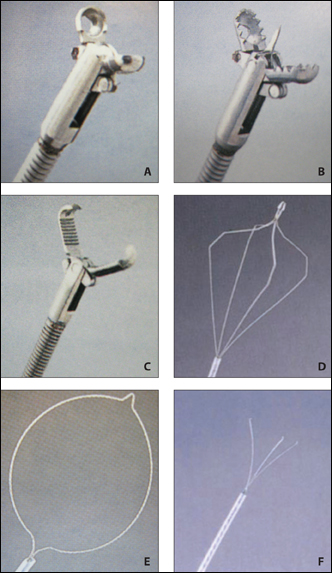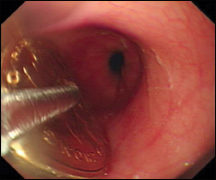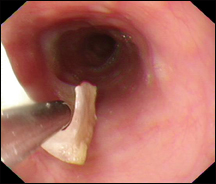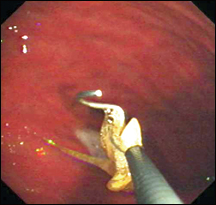Device Use for Foreign Object Ingestion
Q: What Are the Essential Tools for Removing Esophagogastric Foreign Bodies, and When Should I Apply These Devices?
A: Foreign-object ingestion and food-bolus impaction occur commonly. The majority of foreign bodies (ie, foreign objects and food bolus) that reach the stomach will pass spontaneously. However, 10% to 20% of cases will require nonoperative intervention, and approximately 1% will require surgical procedures. Most cases of foreign body ingestion occur in the pediatric age group, with a peak incidence between 6 months and 6 years. In adults, foreign object ingestion occurs more commonly among patients with psychiatric illnesses, mental retardation, alcoholic intoxication, pica and those seeking secondary gain with access to a medical facility.
Since the first report in 1972 on the removal of a foreign body with a flexible endoscope by McKechnie, there has been an increasing application of this method because of its advantages, which include avoidance of surgeries for most patients, a reduced cost, easy accessibility to the esophagus with endoscopy, excellent visualization and simultaneous diagnosis of underlying diseases, and a low morbidity.
Preparation Before Endoscopic Removal of Foreign Bodies
Prior to endoscopic extraction of a foreign body, information regarding the type, form, and size of the foreign body is required to plan the strategy of removal and to select the appropriate instruments. If necessary, it may be useful to conduct a dry run of the procedure before performing it on the patient. A plain radiograph of the upper GI tract with contrast study may be necessary. If a perforation is suspected, water-soluble contrast such as Gastrografin (diatrizoate meglumine/diatrizoate sodium, Bracco) is preferred. If an esophageal foreign body is suspected, a plain radiograph of the chest, including the neck region, should be taken to rule out foreign bodies impacted at the cricopharyngeal sphincter. Children and uncooperative adults often require endotracheal intubation and general anesthesia to ensure that the procedure is carried out safely and successfully.

Images: Wang L, Li Z

Figure 2. Latex protector hood during removal of sharp foreign bodies.

Figure 3. Remove sharp foreign bodies with the overtube.

Figure 4. Food bolus removed en bloc using the retrieval basket.

Figure 5. Food bolus removed in a piece-meal fashion using the retrieval basket.
Endoscopes and Accessories
Standard flexible endoscopes are used in adult patients. A smaller, flexible naso-endoscope with an outer diameter of 6 mm and a special oral retainer is used in children aged younger than 3 years. A double-channel endoscope is used to extract complex and ultra-long objects such as dental prostheses and chopsticks. Accessories used to remove foreign bodies include rat-tooth forceps, snare, W-shaped forceps, retrieval basket, tripod forceps, biopsy forceps, and alligator jaws forceps (Figure 1). A latex protector hood (Figure 2) or an overtube (Figure 3) is used to protect the upper GI tract during removal of sharp foreign bodies. Patients with psychiatric illness need general anesthesia with close monitoring of the heart rate and blood pressure. Other patients may need IV sedation with diazepam when necessary.



When Should I Apply an Endoscopy and the Accessories?
Standard and therapeutic endoscopes are used. Equipment that is essential includes rat-tooth and alligator forceps, polypectomy snare, polyp grasper, retrieval net, overtubes of esophageal and gastric lengths, and a foreign body protector hood. Different endoscopic methods and equipment are used depending on the types of foreign bodies. Food bolus can usually be removed en bloc (Figure 4) or in a piecemeal fashion using the retrieval basket (Figure 5), rat-tooth forceps, or snare. When the endoscope, upon air insufflation and distention of the esophageal lumen, can be steered around the food bolus and into the stomach, the endoscope can be pulled back and used to gently push the food bolus into the stomach. Food boluses should always be pushed carefully into the stomach under direct vision. Coins can be removed easily with a foreign body forceps (rat-tooth, alligator jaws; Figure 6), a snare, or retrieval net. Fish bones (Figure 7) and dental prostheses (Figure 8) are sharp-pointed objects commonly ingested by adults and elderly men. Sharp-pointed objects lodged in the esophagus present a medical emergency. Endoscopic retrieval of these objects is accomplished with retrieval forceps (rat-tooth or alligator jaws forceps) or a snare. The risk of mucosal injury during sharp-object retrieval can be minimized by orienting the object with the point trailing during extraction and by using an overtube or a protector hood attached to the end of the endoscope. Webb reported a 98.8% success rate of endoscopic removal of foreign bodies and a 1.2% failure rate. Li and colleagues reported a success rate for removal of esophageal foreign bodies with a flexible endoscope in 94.1% of cases, with a failure rate of 5.9%. Most of the foreign bodies that fail endoscopic removal are dental prostheses, iron slices, or complex and ultra-long objects. Dental prostheses always impact into the esophageal mucosa, usually involving the muscular layer. In clinical practice, if the risk of esophageal perforation and bleeding is high, as in those cases with dental prostheses deeply embedded into the esophageal wall, it is better to avoid endoscopic attempts and to refer the patient directly to surgery.
Long objects are difficult to remove endoscopically because of difficulty in orientation and grasping. In a retrospective analysis of 542 cases of foreign body ingestion, Velitchkov and colleagues found that all 17 spoon handles longer than 6 cm remained within the stomach and required surgical removal.
Complications
A complication rate of up to 5% is reported for endoscopic treatment, including mucosal laceration, bleeding, pyrexia, and in severe cases, esophageal perforation. The mucosal laceration and bleeding can be treated immediately by endoscopy. Patients with pyrexia should be covered with antibiotics for 2 days. However, patients with esophageal perforation will need surgery.
Excerpted from:
Leung J, Lo SK, eds. Curbside Consultation in Endoscopy: 49 Clinical Questions, Second Edition (pp 13-19). © 2014 SLACK Incorporated.
- References:
- Blaho KE, et al. J Emerg Med. 1998;16:21-26.
- Eisen GM, et al. Gastrointest Endosc. 2002;55:802-806.
- Hachimi-Idrissi S, et al. Eur J Emerg Med. 1998;5:319-323.
- Kamal I, et al. Can J Surg. 1999;42:201-204.
- Li ZS, et al. Gastrointest Endosc. 2006;64:485-492.
- ASGE Standards Practice Committee, et al. Management of ingested foreign bodies and food impactions. Gastrointest Endosc. 2011; doi:10.1016/j.gie.2010.11.010.
- McKechnie JC. Gastroenterology. 1972;62:1047-1051.
- Silva RG, et al. Gastrointest Endosc. 2005;61:615-619.
- Velitchkov NG, et al. World J Surg. 1996;20:1001-1005.
- Webb WA. Gastrointest Endosc. 1995;41:39-51.
- For more information on the Curbside Consultation in Gastroenterology series:
- Visit Healio.com/Books/Gastroenterology.
